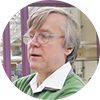Cambridge Healthtech Institute’s 14thAnnual
Optimizing Cell Culture Technology
Enhancing Knowledge for Growing Cells
August 13-14, 2018
By focusing solely on culturing cells, “Optimizing Cell Culture Technology” has long become the established ‘must attend’ international conference for keeping up with emerging trends and technologies that lead to improved qualities
and higher titers. The conference examines breakthrough strategies and technologies for improving cell cultivation, including genome engineering and next-gen analyses and techniques, such as developing cell culture models. Industry experts provide
insights into optimizing conditions as well as cell biology in the effort to improve yield, while also addressing the future of cell culture in an expanding market where demand continues to increase.
Final Agenda
Monday, August 13
8:00 am Short Course Registration Open (Grand Ballroom Foyer) and Morning Coffee (Break Foyer)
9:00 - 11:30 Recommended Short Course*
SC1A: Optimizing Cell Culture Media
Instructors:
Kevin Tan, PhD, Senior Scientist, Irvine Scientific, Inc.
Sven Loebrich, PhD, Senior Development Scientist, ImmunoGen, Inc.
Ronan O’Kennedy, PhD, Director and Principal Consultant, ROK Bioconsulting
Chentian Zhang, PhD, Engineer I, Bristol-Myers Squibb Co.
* Separate registration required.
11:30 Main Conference Registration Open (Grand Ballroom Foyer)
1:00 pm Chairperson’s Opening Remarks
Paula Meleady, PhD, Associate Director, National Institute for Cellular Biotechnology, Dublin City University
1:10 KEYNOTE PRESENTATION:
Advancing Cell Culture Processes
 Michael Laird, PhD, Senior Director & Principal Scientist, Process Development, Genentech, Inc.
Michael Laird, PhD, Senior Director & Principal Scientist, Process Development, Genentech, Inc.
Speed to IND submission is essential in establishing a competitive advantage for a therapeutic product. To further decrease the time and resources required for an IND submission, two strategies have been employed: targeted integration (TI) cell line
development (CLD) and pool for tox (PFT). In addition, high titer, robust processes may also be required for commercial production. This presentation will describe our current strategies from early stage to commercial production.
1:45 Quality by Design-Driven Approaches for Reaching Process Robustness
 Christoph Herwig, PhD, Professor, Bioprocessing Engineering, Vienna University of Technology
(TU Wien), and Founder and Scientific Advisor, Exputec GmbH
Christoph Herwig, PhD, Professor, Bioprocessing Engineering, Vienna University of Technology
(TU Wien), and Founder and Scientific Advisor, Exputec GmbH
Cell culture processes still lack thorough understanding in reaching higher titers and process robustness using process technological means. This contribution shows different aspects of Quality by Design-driven approaches for limiting amino acids
using PAT and automated modelling approaches; model-based experimental designs for targeting maximum information content of the experiment for a given objective, such as media titer optimization or lactate uptake, and scale-down model establishment
to analyze the effect of large-scale inhomogeneities.
2:15 Cell Line Sensitivity from Unexpected Sources: A Systematic Investigation of Upstream Bioprocessing
 Maria Choi, Engineer I, Cell Culture Development, Biogen
Maria Choi, Engineer I, Cell Culture Development, Biogen
A growth and viability decrease of greater than 50% was observed for a mammalian cell line and was correlated to media preparation but ultimately not to individual media components. Upstream operations were systematically tested, and the root cause
was determined to be an inconsistent cleaning procedure. This investigation highlights the importance of upstream operations which may not be ordinarily considered, but which may introduce variability into the cell culture system.
2:45 Refreshment Break (Foyer)
3:15 Using Real-Time Analysis to Optimize Bioprocesses and Enhance Interactive Learning
 Jean-François Hamel, PhD, Research Engineer & Lab Director, Chemical Engineering,
Massachusetts Institute of Technology (MIT)
Jean-François Hamel, PhD, Research Engineer & Lab Director, Chemical Engineering,
Massachusetts Institute of Technology (MIT)
This talk describes how we use real-time analytic tools integrated into process-scale and high-throughput platforms to gain decision-grade information and boost interactive learning during our research. Using these tools generates more actionable
information during the experiment, enhances researchers’ capabilities as they can see the statistical analysis and graphs and visualizations which offer a deeper understanding of the processes while the trial is running. We find that users’
experiences are better and researchers’ engagement in the experiment is deeper.
3:45 Raman Microspectroscopic Analysis of Cell Death and Differentiation
 James M. Piret, PhD, Professor, Michael Smith Laboratories, Chemical & Biological Engineering, The University of
British Columbia
James M. Piret, PhD, Professor, Michael Smith Laboratories, Chemical & Biological Engineering, The University of
British Columbia
Raman spectroscopy is a non-invasive, label-free technology that can analyze cell states based on cellular composition changes. Microspectrometry revealed composition differences over time that distinguished human embryonic stem cells from differentiated
pancreatic cell types, such as by increased protein-to-nucleic acid ratios and increased insulin. We have also shown that Raman microspectrometry can distinguish types of cell death. Apoptotic, necrotic or autophagic CHO cells were compared, including
sorted cells to determine how early the onset of apoptosis could be detected.
4:15 Continuous In-Line Cell Counting and Infection Kinetics Monitoring, a Case Study
 Sean Case, Scientist, Upstream Process Development, Novavax
Sean Case, Scientist, Upstream Process Development, Novavax
Highlights data from in-Line cell counting compared to off-line counting; infection kinetics at various MOIs (0.1 - 1.2) with fed batch process including two different recombinant protein targets; comparability at 10 L vs 50 or 200 L scales to demonstrate
infection kinetics similarity for small scale model qualification (SSMQ).
4:30 An Integrated Approach for Accelerated Cell Line Development and Media Optimization
 David T. Ho, PhD, Manager of New Technologies Group, Research and Development, Irvine Scientific
David T. Ho, PhD, Manager of New Technologies Group, Research and Development, Irvine Scientific
Development of a biotherapeutic protein begins with generating a high-performing stable cell line for manufacturing. Optimization of the culture media is essential to maximize performance and strategies to shorten and streamline this work are in demand.
Here we present an accelerated approach integrating which implements a CHO media platform.
4:45 Breakout Discussions
This session provides the opportunity to discuss a focused topic with peers from around the world in an open, collegial setting. Select from the list of topics available and join the moderated discussion to share ideas, gain insights, establish collaborations
or commiserate about persistent challenges. Then continue the discussion as you head into the lively exhibit hall for information about the latest technologies.
Present and Future Directions for Cell Culture Media
Moderator: Kevin Tan, PhD, Senior Scientist, Irvine Scientific
- What are the drivers for selecting media during your process development
- How to develop and optimize your “dream” media
- Present and Future needs for fed batch media
- Perfusion media: what are the limits of “push to low”
- Scale-down models for evaluating perfusion media
Collecting, Managing and Analyzing Cell Culture Data
Moderator: Neil A. McCracken, P.E., MS, Associate Senior Consultant Engineer, Bioproduct Research and Development, Eli Lilly and Company
- Common in-line and at-line analytical methods
- Best practices for collecting and managing data from various in-line and at-line instruments
- Best practices for analysis of data through tools like traditional fitting or more complex PLS/PCA
CQA Risk Assessment for Attributes Associated with Potency
Moderator: Taro Fujimori, PhD, MBA, Associate Director, Protein Analytics, Science and Technology Biologics, Abbvie Bioresearch Center
- How does your company define the primary mechanism of action for a biotherapeutic? Who in your company is involved in these discussions?
- What data are generated to support the primary mechanism of action? When are these data collected?
- How does your company handle attributes that impact biological activities but are not associated with the primary mechanism of action? For example, signal inhibition and ADCC activities for an antibody drug conjugate.
- How are bioassays used to assess critical quality attributes?
What are the Challenges your Organization is Facing in Deploying a QBD Approach for Development and Commercialization of Biopharmaceuticals
Moderator: Naveen Pathak, PhD, Director, Process Development, Shire
- Challenges in demonstrating the QbD value proposition
- The challenges of deploying QbD approach for Accelerated and Breakthrough Status programs
- Managing differences in QbD approach for development versus legacy products in your organization
- Having the right infrastructure for QbD deployment and connectivity to the quality system
The Pros and Cons of using Transient Material vs Material Generated for a Stable Cell Line
Moderator: Joan Hilly Foster, MS, Senior Field Application Scientist, MaxCyte, Inc.
- Proof of Concept studies, Assay Development, Purification Procedures, Safety Studies and Clinic Trials
- Each step on the journey to the clinic will be discussed whether transient material is a feasible route
- Does it help to mitigates risk and money for a company when a molecule fails in the clinic?
- Is transient transfection a quicker way to the clinic without the time spent to generate a stable cell line?
- Will the FDA even approve a transiently produced product?
Accelerating Biologics Development: Can Transient Expression Systems Speed Candidate Development?
Moderators: Henry C. Chiou, PhD, Director, Product Development, Thermo Fisher Scientific
Jonathan Zmuda, Director, Cell Biology, Thermo Fisher Scientific
- Can transient expression systems be predictive of the characteristics of proteins expressed in stable cell systems?
- What are some factors that can help align transient expression systems to downstream production systems?
- When is the optimal time to transition from transient to stable expression?
5:30 Grand Opening Reception in the Exhibit Hall with Poster Viewing (Grand Ballroom)
7:00 End of Day
Tuesday, August 14
7:30 am Registration Open and Morning Coffee (Grand Ballroom Foyer)
7:55 Chairperson’s Remarks
Bhanu Chandra Mulukutla, PhD, Principal Scientist, Process Development, Pfizer, Inc.
8:00 Proteomic and Phosphoproteomic Characterisation of Growth of Recombinant Chinese Hamster Ovary Cells
 Paula Meleady, PhD, Associate Director, National Institute for Cellular Biotechnology, Dublin City University
Paula Meleady, PhD, Associate Director, National Institute for Cellular Biotechnology, Dublin City University
Despite phosphorylation being a hugely important post-translational modification, its role in regulating CHO bioprocess-relevant phenotypes has not been studied in detail to date. We describe the phosphoproteomic characterization of CHO cells
during growth in culture and in cells subject to temperature shift. Using advanced LC-MS/MS techniques we have characterised > 8000 CHO-specific phosphorylation sites and identified >1000 differentially expressed phosphopeptides in these
studies. Phosphoproteins have the potential to be cell engineering targets to improve efficiency of recombinant protein production.
8:30 CHO Growth under Stress Conditions
Neil A. McCracken, P.E., MS, Associate Senior Consultant Engineer, Bioproduct Research and Development, Eli Lilly and Company
9:00 Systematic Analysis of Trace Metals on Therapeutic Protein Production in CHO Cells
 Kyle McHugh, PhD, Research Scientist, Upstream Biologics Process Development, Bristol-Myers Squibb Co.
Kyle McHugh, PhD, Research Scientist, Upstream Biologics Process Development, Bristol-Myers Squibb Co.
A systematic approach was taken to better understand how the levels of specific trace metals may be used to regulate cell culture process parameters and protein quality attributes including N-glycan distribution, charge variant profiles, and
protein aggregation. Design of Experiments in high-throughput Tecan liquid handler production runs was used to assess the impact of 12 different metals on 4 proteins of therapeutic interest and confirmed in benchtop bioreactors to generate
samples for transcriptomic and metabolomics analysis. Results from the high-throughput screens and follow-up studies will be presented.
9:30 Novel Analytical Solutions for Cell Line Development
 Carolanne Doherty, PhD, Manager, Sales and Marketing, Valitacell
Carolanne Doherty, PhD, Manager, Sales and Marketing, Valitacell
Valitacell is offering the biopharmaceutical industry novel methods to transform the complex manufacturing process that produces bio-therapeutic drugs by making it faster and more cost effective. We aim to fill the gap with our analytical
technologies to promote the chance of identifying high-producing stable clones in a reduced time frame.
9:45 Coffee Break in the Exhibit Hall with Poster Viewing (Grand Ballroom)
10:30 Modulation of Half Antibody and Aggregate Formation in a CHO Cell Line Expressing a Bispecific Antibody
.png) Natalia Gomez, PhD, Principal Scientist, Amgen, Inc.
Natalia Gomez, PhD, Principal Scientist, Amgen, Inc.
We investigated the modulation of impurity levels in a stable CHO cell line X expressing a bispecific antibody (LC1-HC1+LC2-HC2). In particular, this cell line responded to cell culture temperature by decreasing half antibody formation
from 14% to <3% when temperature changed from 36°C to 32.5°C. However, lower temperature also correlated with increased high molecular weight (HMW) species from 4% to 10%. Overall, we identified culture conditions that could
alter impurities levels and the overall process yield.
11:00 Challenges in Cell Culture Platform Development of mAb Production with Site-Specific Incorporation of Non-Natural Amino Acid for ADC Generation
Weimin Lin, PhD, Principal Scientist, Cell Culture Development, Ambrx, Inc.
We successfully generated a CHO-K1 cell line, stably expressing engineered amber suppressor tRNA and its cognate tRNA synthetase to achieve high production of monoclonal antibodies (mAbs) containing nnAAs. The stable cell lines were further
evolved using CRISPR/Cas9 genome editing technology. In this presentation, we will discuss the challenges in cell culture platform development including cell line engineering, systematic DoE-based approaches on optimal chemically defined
media and cell culture processes, and, strategies for scale up to clinical and commercial scales
11:30 Engineering Amino Acid Metabolism of CHO Cells towards Reduced Novel Growth Inhibitor Production and Amino Acid Prototrophy
 Bhanu Chandra Mulukutla, PhD, Principal Scientist, Process Development,
Pfizer, Inc.
Bhanu Chandra Mulukutla, PhD, Principal Scientist, Process Development,
Pfizer, Inc.
In this study, genetic engineering approaches were undertaken to reduce the production of inhibitory byproducts produced from phenylalanine-tyrosine or branched chain amino acid (BCAA) catabolic pathways. Four enzymes in phenylalanine-tyrosine catabolic pathway, originally not expressed in CHO cells, were overexpressed ectopically. Cells overexpressing these enzymes produced lower levels of corresponding byproducts and were able to grow and proliferate in tyrosine-free environment (tyrosine prototrophy). Clones with the KO event produced negligible amounts of inhibitory products associated with BCAA catabolism in fed-batch cultures. As a result of this, these clones reached much higher peak cell densities and produced significantly higher levels of titers in fed-batch cultures.
12:00 pm Choosing the Right Cell Engineering Technology on CHO Productivity and Therapeutic Development Timelines
 Joan Foster, Senior Field Applications Scientist, MaxCyte
Joan Foster, Senior Field Applications Scientist, MaxCyte
Working with the manufacturing host cell early in development produces sufficient quantities of candidates for extensive characterization and progression of promising candidates in a cost-efficient manner. Proper means of cell engineering
drive rapid, scalable production of proteins in the manufacturing cell background while successfully maintaining flexibility in downstream culture processes. This presentation discusses the high performance and flexibility of MaxCyte’s
cell engineering technology and how it impacts therapeutics efficacy and fast-track biotherapeutic development.
 12:30 Luncheon Presentation: ExpiCHO, Expi293 and ExpiSf: High Titer Protein Expression for Streamlined Pharmaceutical Development
12:30 Luncheon Presentation: ExpiCHO, Expi293 and ExpiSf: High Titer Protein Expression for Streamlined Pharmaceutical Development
 Jonathan Zmuda, PhD, Director, Cell Biology, Thermo Fisher Scientific
Jonathan Zmuda, PhD, Director, Cell Biology, Thermo Fisher Scientific
The Expi Expression Systems comprise three different cell hosts to provide researchers with unprecedented access to high-titer recombinant proteins in support of all phases of drug/vaccine development. Recent additions to the Expi family
of products include GMP banked Expi293 cells, GMP ExpiCHO-S cells (late 2018) and ExpiCHO Stable Production Media to allow for ease of transition from transient to stable ExpiCHO. Here, we introduce and discuss the similarities and
differences among the three Expi systems.
1:15 Dessert Refreshment Break in the Exhibit Hall with Poster Viewing (Grand Ballroom)
1:55 Chairperson’s Remarks
Carolanne Doherty, PhD, Manager, Marketing and Sales, Valitacell
2:00 Driving Commercial Biologics Process Understanding through the Application of Metabolomics Testing
 Ricardo Lewis, MSc, MS&T Associate Scientist, Manufacturing Sciences & Technology, Bristol-Myers
Squibb Co.
Ricardo Lewis, MSc, MS&T Associate Scientist, Manufacturing Sciences & Technology, Bristol-Myers
Squibb Co.
This presentation will explore a methodology for incorporating routine metabolomics testing into a commercial biologics process for continuous improvement and process understanding. LC-MS and NMR data will be presented from a legacy commercial
process where metabolomics was used to trend and monitor campaign performance, as well as to establish raw material variability and impact to process performance. Finally, sustainability of this methodology in a commercial biologics
space will be addressed.
2:30 13C Metabolic Flux Analysis Identifies Limitations to Increasing Specific Productivity in Fed-Batch and Perfusion
 Neil Templeton, PhD, Senor Scientist, Upstream Process Development Engineering, Merck Research
Laboratories
Neil Templeton, PhD, Senor Scientist, Upstream Process Development Engineering, Merck Research
Laboratories
13C-Metabolic Flux Analysis (13C-MFA) was utilized to compare the stationary phase of a fed-batch process to a perfusion process producing the same product by the same clone. The fed-batch process achieved significantly
higher specific productivity, while gross growth rate was approximately 80% greater in the perfusion process. When considering gross growth rate and IgG specific productivity, total protein-specific productivity differed little, offering
rationale for the observed central carbon pathway similarities.
3:00 In vivo Quantification of Mitochondrial Shuttle Activities via 13C Flux Analysis in mAB Producing CHO Cells
 Ralf Takors, PhD, Professor, Institute of Biochemical Engineering, University of Stuttgart
Ralf Takors, PhD, Professor, Institute of Biochemical Engineering, University of Stuttgart
We have developed a technology that identifies the in vivo mitochondrial shuttle activities of CHO cells during typical production conditions. The compartment-specific 13C analysis
distinguishes between cytosol and mitochondrion thereby disclosing the tight coupling of mitochondrial and cytosolic metabolism and underpinning the crucial role of mitochondrion not only as a provider of ATP but also as an essential
part of metabolism. Metabolic flux patterns serve as a sound basis for deriving process and metabolic engineering strategies for optimizing mAB productivities further.
 3:30 Refreshment Break in the Exhibit Hall with 1st Session Poster Winner Announced (Grand Ballroom)
3:30 Refreshment Break in the Exhibit Hall with 1st Session Poster Winner Announced (Grand Ballroom)
4:15 Cell Culture Media Characterization and Optimization Using DOE Combined with Multivariate Methods
 Ronan O’Kennedy, PhD, Consulting Bioprocess Specialist, ROK Bioconsulting
Ronan O’Kennedy, PhD, Consulting Bioprocess Specialist, ROK Bioconsulting
Quantitative structural activity relationship modelling (QSAR) will be presented as an effective tool to characterize the compositional variability of media containing peptones or hydrolysates. Used in combination with DOE medium optimisation,
compositional variability can be linked to cell culture performance. The resulting QSAR based model provides a design space of the effect of compositional variability of commercially available hydrolysates. The model is used to select
and optimize peptones/hydrolysates and predict the effects of hydrolysate raw material lot variability on cell culture performance.
4:45 Manipulating Glycan Profile and Application of a High-Throughput Capillary Western Method Using Lectins for Detection
Silvino (Serry) Sousa, MSc, Senior Scientist, Global Protein Sciences, AbbVie
I will discuss approaches for modulating N-linked glycosylation of recombinant therapeutic proteins by manipulating media, process and/or genetics of the host cell factory. What is also needed is a rapid, simple, yet protein and titer
agnostic method for deriving detailed glycan signature directly and simultaneously from multiple samples of cell culture conditioned medium. I will review methods that we have implemented for rapidly screening for glycan signatures
directly from cell culture supernatants.
5:15 End of Conference
6:00 - 8:30 Recommended Dinner Short Course*
SC7B: Analytical Strategies for Comparability in Bioprocess Development
Instructor: Christine P. Chan, PhD, Principal Scientist/Technical Lead, Global Manufacturing Science & Technology, Specialty Care Operations, Sanofi
* Separate registration required.